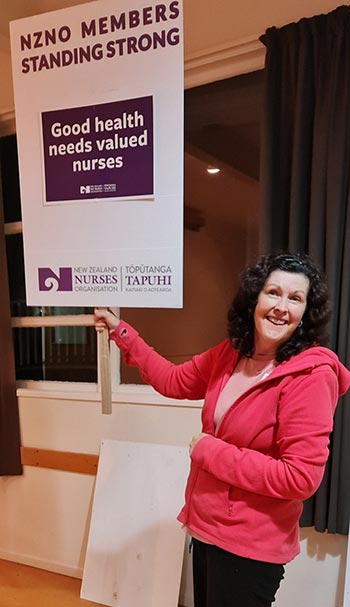
It was only the frantic hard work of NZNO staff and members throughout the Queen’s Birthday holiday weekend which managed to pull together enough nurses and staff to provide basic life-preserving and patient safety services during the June 9 strike. The DHB then withdrew its threat of legal action, she said.
‘It was close’
“It was close, but we got there,” Alexander told Kai Tiaki Nursing New Zealand. “It was a really big team effort [which averted it]. Delegates and staff were all weekend calling people, one by one, trying to persuade them [to work through the strike],” she said.
If CDHB had won a legal challenge over inadequate staffing levels, the strike would have been called off, Alexander said.
Under the Employment Relations Act’s public health sector code of good faith, as part of collective bargaining NZNO was obliged to work with DHBs to ensure adequate staffing was provided during strike action to maintain patient safety and preserve life.
Painstaking
This had required weeks of painstaking negotiations with DHBs involving NZNO staff, delegates and members, Alexander said. “Just finding people willing to work through the strike, to provide life-preserving services (LPS), was challenging and put a lot of pressure on us staff and delegates.”
Members weren’t usually keen, which was understandable. Yet providing these services was essential to allow the strike to proceed, Alexander said.
NZNO acting manager, professional and nursing services, Kate Weston acknowledged it was a “big ask” for members to provide LPS cover when they wanted to be on the picket line – but failing to fill those rosters gave DHBs an opening for legal action. “These members putting themselves up for LPS are equally important to a strike going ahead.”
Wherever possible, non-union staff were asked to work. However as NZNO membership was so high, it was not always possible. “They voted to strike so people want to strike and be out there picketing, so it’s quite a big ask to be part of LPS,” she said.
Nurses – unlike some other essential services such as police – were legally able to take industrial strike action under the ERA, but only if LPS rosters were agreed and filled, Weston said.
NZNO had spent weeks negotiating with the country’s 20 DHBs on what these would look like. As well as CDHB, there had also been sticking points at Taranaki, Southern and Auckland DHBs requiring adjudication; however these had all been resolved by strike day, Weston said. “Thanks to the really hard work of members and staff we came to agreement with all DHBs over the [Queen’s Birthday] weekend.”
Staffing inflated
Some DHBs inflated the required staffing beyond what DHBs would have on an ordinary day, which had caused “major distress” for members trying to organise contingency staffing in good faith, Weston said.
“Seventy to 80 per cent of the time, there are not enough staff to meet patients’ needs.”



